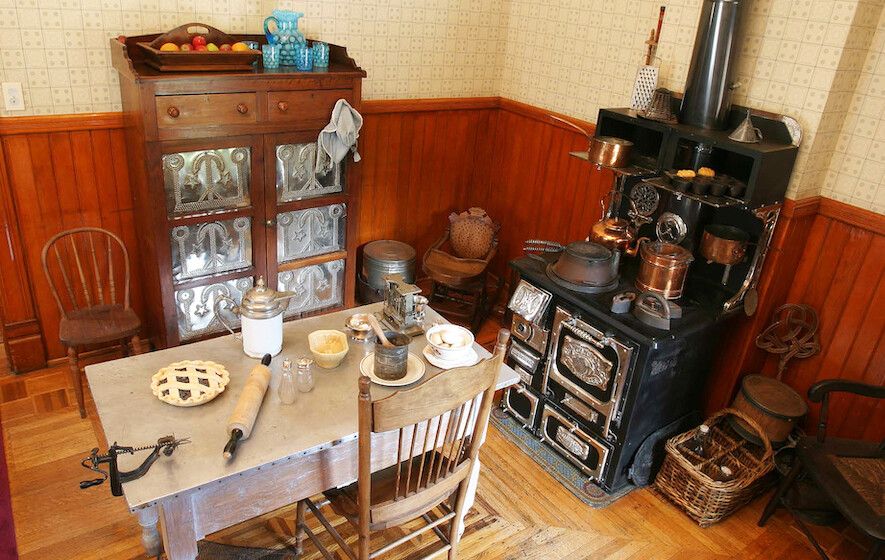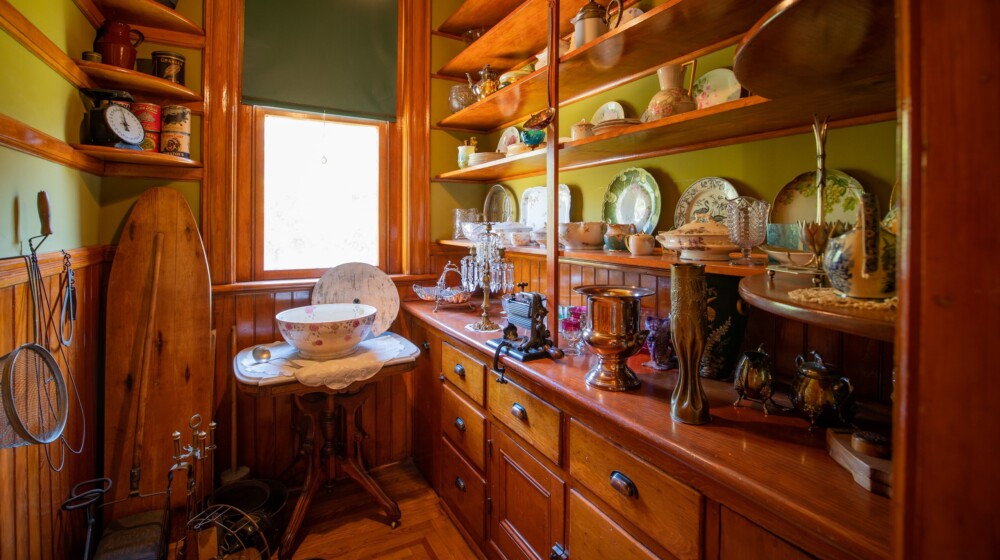Kitchen & Pantry
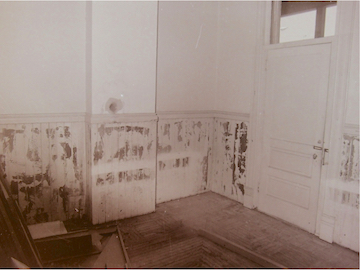 In her interview with Heritage Square, Jessie Jean (Higley) Lane remembered that her family had a prep table here in the kitchen as well as a table for eating, and stored cans on the shelves in the pantry. The Gammel family also had a table for eating in the kitchen, and interview notes from Milton Ponder (who was married to Annie Gammel) indicate the room was often crowded with eight or more people squeezed around the table for meals. Georgia (Gammel) Valliere recalled that their family had a wood-burning Majestic stove (the same brand as the one we now have at Rosson House), with a water tank attached to the stove on the left. Water damage from the tank can still be seen on the restored floor on that corner of the room. She also said her family kept their refrigerator out in the enclosed back porch area.
In her interview with Heritage Square, Jessie Jean (Higley) Lane remembered that her family had a prep table here in the kitchen as well as a table for eating, and stored cans on the shelves in the pantry. The Gammel family also had a table for eating in the kitchen, and interview notes from Milton Ponder (who was married to Annie Gammel) indicate the room was often crowded with eight or more people squeezed around the table for meals. Georgia (Gammel) Valliere recalled that their family had a wood-burning Majestic stove (the same brand as the one we now have at Rosson House), with a water tank attached to the stove on the left. Water damage from the tank can still be seen on the restored floor on that corner of the room. She also said her family kept their refrigerator out in the enclosed back porch area.
The kitchen sink is original to the home, though it had been moved into the pantry at some time. Original pipes and marks on the wall were found in the corner of the kitchen outside the pantry, indicating this was its initial location, and it was moved there during restoration. All wallpaper in this room had been removed at some time, but scraps were found under the molding at the top of the kitchen wainscotting, and restorers were able to ascertain what the original wallpaper looked like from those scraps.
The built-in storage in the pantry is original to the home, though the trap door found there during restoration was not. When restorers lifted the trap door, they found corks and bottles estimated to be from the Prohibition Era. Unfortunately, during the restoration, the trap door was removed since it wasn’t original to the home. Additionally, at some point an exterior door had been added to the pantry that led onto the enclosed back porch area. It was also removed during restoration, and the opening was repaired.
There are several interesting artifacts in these rooms that visitors want to know more about. Here are a few of our favorites, in alphabetical order (if there are any we’ve missed that you’d like to know more about, please let us know):
Kitchen:
-
Baking Table
A wood and metal baker’s table, circa 1897, also known as a possum belly table or a Hoosier table. It features a zinc top, a bread board, two small drawers for holding utensils, and two curved, “possum belly” bins, the bottoms of which are zinc. The larger of the two bins was used to hold flour, while the divided bin was for corn meal or sugar. This table was owned by the Goldberg family, and was in use while they lived at Rosson House.
-
Fire Extinguisher
 A Lofstrand Company (Rockville, Maryland) copper fire extinguisher with red rubber hose, a wood and steel carrying handle, and a brass pump with a steel handle that has been painted red. The copper tank would have been filled with water, and the pump operated to direct a stream of water through the rubber hose to the base of the fire.
A Lofstrand Company (Rockville, Maryland) copper fire extinguisher with red rubber hose, a wood and steel carrying handle, and a brass pump with a steel handle that has been painted red. The copper tank would have been filled with water, and the pump operated to direct a stream of water through the rubber hose to the base of the fire. -
Highchair
This late 19th century, Eastlake style wooden highchair is made of walnut with a perforated burl panel on the seat and the back. A small pull knob underneath the seat releases a mechanism allowing chair legs to splay out and down. In this lower position, the curved inner legs convert the chair into a rocker.
-
Refrigerator
A pine wood ice-box refrigerator made by the Grand Rapids Refrigerator Company, circa 1911. The upper compartment is for a block of ice (approximately 25 pounds) and the lower compartment used for food storage. Both compartments are insulated (usually with sawdust and/or rags) and are lined in metal (likely zinc). The refrigerator has a drain and pipe at the back for water to empty as the ice melted. The water would travel down the pipe and be collected by a drip pan underneath the refrigerator.
-
Stove
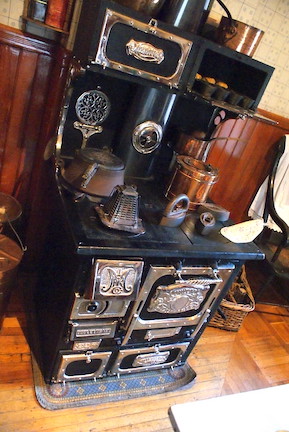 “Monarch Malleable Range Style N” cast Iron, steel and nickel composite cookstove, made in Beaver Dam, Wisconsin. The stove converts between coal and wood burning as its fuel source. It has four burners and an oven, and has two foldable trivets to keep pots off direct heat while still keeping them warm, along with two warming areas at the top. This cookstove is originally from a hotel in Tombstone, Arizona. During the restoration of the Rosson House, it was disassembled, cleaned, replated and re-nickeled.
“Monarch Malleable Range Style N” cast Iron, steel and nickel composite cookstove, made in Beaver Dam, Wisconsin. The stove converts between coal and wood burning as its fuel source. It has four burners and an oven, and has two foldable trivets to keep pots off direct heat while still keeping them warm, along with two warming areas at the top. This cookstove is originally from a hotel in Tombstone, Arizona. During the restoration of the Rosson House, it was disassembled, cleaned, replated and re-nickeled. -
Waffle Iron
A cast iron waffle iron manufactured by the The Griswold Manufacturing Co., Erie, Pennsylvania, circa 1908.
-
Washing Machine
 A Happy Home Steam Washer, made of copper alloy, from the Happy Home Steam Washing Co., Sycamore, Ohio, circa 1915. The label says its capacity is 13-17 sheets, and that it works “on any gas, oil, or cook stove”. Laundry, soap, and water would be placed in the washer drum while it was on the stove, and the laundry would be agitated by turning the handle on the side.
A Happy Home Steam Washer, made of copper alloy, from the Happy Home Steam Washing Co., Sycamore, Ohio, circa 1915. The label says its capacity is 13-17 sheets, and that it works “on any gas, oil, or cook stove”. Laundry, soap, and water would be placed in the washer drum while it was on the stove, and the laundry would be agitated by turning the handle on the side.
Pantry:
-
Biscuit Box
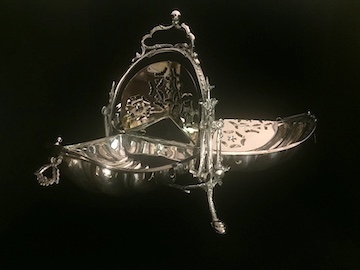 A silver plated, reproduction biscuit box made for holding small cookies during afternoon tea.
A silver plated, reproduction biscuit box made for holding small cookies during afternoon tea. -
Canning Sterilizer
A large, copper sterilizer or water bath used for canning. The tank would be placed on a stove and filled with water, covering the tops of jars of food needing to be sterilized, then boiled for a certain amount of time to preserve the safety and quality of the food.
-
Fluting Iron
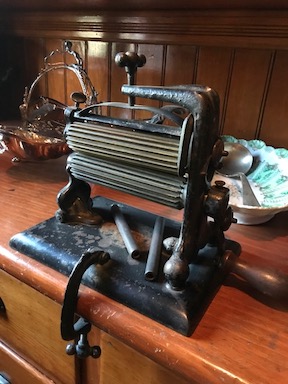 A mechanized fluting iron, manufactured by M. Greenwood & Co., circa 1870. This type of iron is made of black painted cast iron and used for fluting or creating ruffles, such as those that appear on collars, cuffs, and hems. These irons are also called pleaters, crimpers or ruffle irons. (See a non-mechanized fluting iron from the National Museum of American History.)
A mechanized fluting iron, manufactured by M. Greenwood & Co., circa 1870. This type of iron is made of black painted cast iron and used for fluting or creating ruffles, such as those that appear on collars, cuffs, and hems. These irons are also called pleaters, crimpers or ruffle irons. (See a non-mechanized fluting iron from the National Museum of American History.) -
Punch Bowl
 A large, ceramic punch bowl with metal lid, made by the Royal Bonn company between 1885 and 1920. This punch bowl belonged to the Gammel family and, according to Georgia (Gammel) Valliere, was used at outdoor parties with the lid to keep insects out of the punch.
A large, ceramic punch bowl with metal lid, made by the Royal Bonn company between 1885 and 1920. This punch bowl belonged to the Gammel family and, according to Georgia (Gammel) Valliere, was used at outdoor parties with the lid to keep insects out of the punch.
Discover what food was available in Phoenix at the turn-of-the-century in our blog articles, Bon Appétit and Victorian Food. Learn about the history of food preservation from our blog articles, On Ice and Can It!, and about the history of spicy food in Arizona from our article, Spicing It Up. Learn about the necessity of gardening through history’s tough times by reading our article, Victory Gardens. And finally, explore another use for kitchens at the turn-of-the-century by reading our article, Victorian Laundry.
Cocina Y Alacena
 En su entrevista con Heritage Square, Jessie Jean (Higley) Lane recordó que su familia tenía en la cocina una mesa de preparación y otra para comer, y que guardaban latas en los estantes de la alacena. La familia Gammel también tenía una mesa para comer en la cocina, y notas de la entrevista de Milton Ponder (quien estuvo casado con Annie Gammel) indican que ese espacio a menudo se llenaba con ocho o más personas apretujadas alrededor de la mesa para comer. Georgia (Gammel) Valliere recordó que su familia tenía una estufa de leña Majestic (la misma marca que tenemos actualmente en la Casa Rosson), con un tanque de agua conectado a la estufa por el lado izquierdo. Daños por agua aún se pueden ver en el piso restaurado en esa esquina de la habitación. También mencionó que su familia tenía el refrigerador afuera en la parte cerrada del porche trasero.
En su entrevista con Heritage Square, Jessie Jean (Higley) Lane recordó que su familia tenía en la cocina una mesa de preparación y otra para comer, y que guardaban latas en los estantes de la alacena. La familia Gammel también tenía una mesa para comer en la cocina, y notas de la entrevista de Milton Ponder (quien estuvo casado con Annie Gammel) indican que ese espacio a menudo se llenaba con ocho o más personas apretujadas alrededor de la mesa para comer. Georgia (Gammel) Valliere recordó que su familia tenía una estufa de leña Majestic (la misma marca que tenemos actualmente en la Casa Rosson), con un tanque de agua conectado a la estufa por el lado izquierdo. Daños por agua aún se pueden ver en el piso restaurado en esa esquina de la habitación. También mencionó que su familia tenía el refrigerador afuera en la parte cerrada del porche trasero.
 El lavabo de la cocina es el original de la casa, aunque en algún punto estuvo instalado en la alacena. Tubería original y marcas en la pared se encontraron en la esquina de la cocina afuera de la alacena, indicando que esta fue su ubicación inicial y fue cambiado de lugar durante la restauración. Todo el papel tapiz en este cuarto fue removido en algún punto, pero se encontraron rastros debajo de la moldura sobre el revestimiento de madera de la cocina, y los restauradores pudieron confirmar cómo se veía el papel tapiz original a partir de estos rastros.
El lavabo de la cocina es el original de la casa, aunque en algún punto estuvo instalado en la alacena. Tubería original y marcas en la pared se encontraron en la esquina de la cocina afuera de la alacena, indicando que esta fue su ubicación inicial y fue cambiado de lugar durante la restauración. Todo el papel tapiz en este cuarto fue removido en algún punto, pero se encontraron rastros debajo de la moldura sobre el revestimiento de madera de la cocina, y los restauradores pudieron confirmar cómo se veía el papel tapiz original a partir de estos rastros.
La estantería en la alacena es original a la casa, aunque la trampilla que se encontó durante la restauración no lo es. Cuando los restauradores abrieron la trampilla, encontraron corchos y botellas que se estima que son de la época de la Prohibición. Desafortunadamente, durante la restauración, la trampilla fue removida ya que no era original a la casa. Adicionalmente, en algún punto una puerta exterior fue añadida a la alacena, la cual daba accceso al área cerrada del porche trasero. También fue removida durante la restauración, y el hueco fue reparado.
Hay algunos artefactos interesantes en esta habitación de los cuales los visitantes quisieran saber más. Aquí están algunos de nuestros favoritos, en orden alfabético (si hay alguno que ha faltado del cual quisieras saber más, háznoslo saber):
Cocina:
-
Mesa para Hornear
Una mesa de panadero de madera y metal de alrededor de 1897, también concidas como mesa de barriga de zarigüeya (possum belly) o mesa Hoosier. Cuenta con una cobertura de zinc, una tabla para pan, dos cajones pequeños para guardar utensilios, y dos contenedores curvos de “barriga de zarigüeya” que tenían fondos hechos de zinc. El contenedor más grande era para guardar harina, mientras que el contenedor con divisiones era para harina de maíz o azúcar. Esta mesa era propiedad de la familia Goldberg y fue utilizada cuando vivieron en la Casa Rosson.
-
Extintor de Incendios
 Un extintor de incendios de Lofstrand Company (Rockville, Maryland) con una manguera roja de caucho, extintor de cobre con manguera de caucho roja, un asa de transporte de madera y acero pintada de rojo. El tanque de cobre se llenaba de agua y la bomba funcionaba para dirigir el choro de agua a través de la manguera hacia la base del fuego.
Un extintor de incendios de Lofstrand Company (Rockville, Maryland) con una manguera roja de caucho, extintor de cobre con manguera de caucho roja, un asa de transporte de madera y acero pintada de rojo. El tanque de cobre se llenaba de agua y la bomba funcionaba para dirigir el choro de agua a través de la manguera hacia la base del fuego. -
Silla Alta
Esta silla alta de madera estilo Eastlake de finales del siglo 19 está hecha de nogal con un panel perforado en el asiento y la el respaldo. Una pequeña perilla bajo el asiento llibera un mecanismo que permite que las patas de la silla se abran hacia afuera y hacia abajo. En esta posición más Baja, las patas interiores curvas convierten la silla en una mecedora.
-
Refrigerador
Un refrigerador de madera de pino con caja de hielo fabricado por Grand Rapids Refrigerator Company, alrededor de 1911. El compartimiento superior es para un bloque de hielo (aproximadamente 25 libras) y el compartimiento inferior era para almacenar comida. Ambos compartimientos están aislados (comúnmente con asserín y/o trapos) y están revestidos de metal (probablemente zinc). El refrigerador tiene un desagüe en la parte posterior para que el agua se vaciara mientras el hielo se derretía. El agua viajaría por la tubería y sería recolectada en una bandeja de goteo debajo del refrigerador.
-
Estufa
 Estufa de cocina de compuesta de fundido, acero, y níquel “Monarch Malleable Range Style N”, fabricada en in Beaver Dam, Wisconsin. La estufa se convierte de quemar carbón a leña como fuente de combustible. Tiene cuatro hornillas y un horno, y tiene dos reposaollas plegables para mantener las ollas alejadas del calor directo mientras las mantiene caliente, junto con dos áreas de calentamiento en la parte superior. Esta estufa originalmente se encontraba dentro de un hotel en Tombstone, Arizona. Durante la restauración de la Casa Rosson, fue desarmada, limpiada, rechapada y re-niquelada.
Estufa de cocina de compuesta de fundido, acero, y níquel “Monarch Malleable Range Style N”, fabricada en in Beaver Dam, Wisconsin. La estufa se convierte de quemar carbón a leña como fuente de combustible. Tiene cuatro hornillas y un horno, y tiene dos reposaollas plegables para mantener las ollas alejadas del calor directo mientras las mantiene caliente, junto con dos áreas de calentamiento en la parte superior. Esta estufa originalmente se encontraba dentro de un hotel en Tombstone, Arizona. Durante la restauración de la Casa Rosson, fue desarmada, limpiada, rechapada y re-niquelada. -
Plancha de Waffles
Una plancha de waffles de hierro fundido fabricada por The Griswold Manufacturing Co., Erie, Pennsylvania, alrededor de 1908.
-
Lavadora
 Lavadora a vapor Happy Home, hecha de aleación de cobre, de Happy Home Steam Washing Co., Sycamore, Ohio, alrededor de 1915. La etiqueta dice que su capacidad es de 13-17 sábanas, y que funciona “en cualquier estufa de cocina, de aceite o de gas”. Ropa sucia, jabón, y agua se colocaban dentro del tambor mientras estaba en la estufa, y la ropa se agitaría al girar la manija lateral.
Lavadora a vapor Happy Home, hecha de aleación de cobre, de Happy Home Steam Washing Co., Sycamore, Ohio, alrededor de 1915. La etiqueta dice que su capacidad es de 13-17 sábanas, y que funciona “en cualquier estufa de cocina, de aceite o de gas”. Ropa sucia, jabón, y agua se colocaban dentro del tambor mientras estaba en la estufa, y la ropa se agitaría al girar la manija lateral.
Alacena:
-
Caja de Galletas
 Reproducción de caja de galletas con chapada en plata hecha para guardar galletas pequeñas durante el té de la tarde.
Reproducción de caja de galletas con chapada en plata hecha para guardar galletas pequeñas durante el té de la tarde. -
Esterilizador de Conservas
Un esterilizador grande de cobre o tina que se usa para enlatar. El tanque se colocaba en la estufa y se llenaba de agua, cubriendo la parte superior de los frascos que necesitaban esterilizarse, luego se hervían por cierto tiempo para preservar la seguridad y calidad de la comida.
-
Plancha para Acanalar
 Plancha mecanizada para acanalar, fabricada por Greenwood & Co., de alrededor de 1870. Este tipo de plancha está hecha de hierro fundido pintado de negro y se utiliza para acanalar o crear rizos, como los que aparecen en los cuellos, puños, y bordes de camisas. Estas planchas también se llamaban plisadores o rizadores, o planchas de rizos. (Ve una plancha para acanalar no mecanizada del Museo Nacional de Historia Americana).
Plancha mecanizada para acanalar, fabricada por Greenwood & Co., de alrededor de 1870. Este tipo de plancha está hecha de hierro fundido pintado de negro y se utiliza para acanalar o crear rizos, como los que aparecen en los cuellos, puños, y bordes de camisas. Estas planchas también se llamaban plisadores o rizadores, o planchas de rizos. (Ve una plancha para acanalar no mecanizada del Museo Nacional de Historia Americana). -
Ponchera
 Una ponchera grande de cerámica con tapa de metal, hecha por la compañía Royal Bonn entre 1885 y 1920. Esta ponchera perteneció a la familia Gammel y, de acuerdo con Georgia (Gammel) Valliere, fue utilizada en fiestas al aire libre con la tapa para mantener a los insectos fuera del ponche.
Una ponchera grande de cerámica con tapa de metal, hecha por la compañía Royal Bonn entre 1885 y 1920. Esta ponchera perteneció a la familia Gammel y, de acuerdo con Georgia (Gammel) Valliere, fue utilizada en fiestas al aire libre con la tapa para mantener a los insectos fuera del ponche.
Descubre qué comida estaba disponible en Phoenix a principios del siglo XX en nuestros artículos de blog, Bon Appétit y Comida Victoriana. Aprende acerca de la historia de la preservación de alimentos de nuestros artículos de blog, Sobre Hielo y Enlátalo, y acerca de la historia de la comida picante en Arizona de nuestro artículo Sazonándo. Aprenda sobre la necesidad de la jardinería a través de los tiempos difíciles de la historia leyendo nuestro artículo, Jardines de la victoria. Y finalmente, explora otro uso para las cocinas del principio del siglo XX leyendo nuestro artículo, Lavandería Victoriana.
Siguiente Página: Los Extras Volver a la Página Principal
